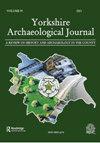Landscape and Settlement in the Vale of York: Archaeological Excavations at Heslington East, York, 2003–13
IF 0.2
0 ARCHAEOLOGY
引用次数: 1
Abstract
presentation is framed along the lines of a rather traditional historical narrative – essentially fitting the archaeological evidence into a framework created by the limited Classical sources. Such an approach is perfectly defensible, but it does miss the opportunities provided by contemporary archaeological thinking. To take one example, much of the interpretation is defined by the categories of Native versus Roman, with the latter represented by the military or officials. Interestingly agency in explaining past decisions is essentially seen to pass from the one to the other. As we have seen in previous section, the post AD 70/71 settlement is represented as an externally imposed foundation. For me much of the interest in a site like this lies in much more complex explanations as the processes of cultural change were not simply about imposition (a point well understood in the context of the Iron Age phases here). In seeking to understand what was to become a failed Roman settlement within about 50 years, we might want to start by thinking about who came to live there at this period, what they were doing and why. Certainly there would have been soldiers, at least passing-by if not always resident, but who else? The category of ‘native’ is insufficient as the population presumably included people from this region, from other parts of Britain and also perhaps those from Gaul and Germany who were taking advantage of the opportunities of conquest. How does the evidence for things found on the site like millstones, pottery, glass and trinkets map on to this, and what can they tell us about the nature of these communities and their various relationships with the imperial power? The opportunity for using this excellent material to address such questions should not now be lost. We should be writing stories that move far beyond the shackles of the Classical texts which seem to have constrained the project as presented here just a little.约克河谷的景观和聚落:赫斯灵顿东部的考古发掘,约克,2003-13
呈现是沿着相当传统的历史叙事的路线构建的——本质上是将考古证据纳入由有限的古典文献来源创建的框架中。这样的方法是完全可以辩护的,但它确实错过了当代考古思想提供的机会。举个例子,大部分解释是由原住民与罗马人的类别定义的,后者由军队或官员代表。有趣的是,在解释过去的决定时,机构基本上被视为从一个传递到另一个。正如我们在上一节中所看到的,公元70/71年后的定居点被视为外部强加的基础。对我来说,对这样一个网站的兴趣很大程度上在于更复杂的解释,因为文化变化的过程不仅仅是强加的(这一点在这里的铁器时代阶段的背景下得到了很好的理解)。在试图了解在大约50年内,什么会成为一个失败的罗马定居点时,我们可能想从思考谁在这个时期来到那里生活开始,他们在做什么以及为什么。当然会有士兵,如果不是一直住在这里的话,至少会路过,但还有谁呢?“本地人”的类别是不够的,因为人口可能包括来自该地区、英国其他地区的人,也可能包括那些利用征服机会的高卢人和德国人。在遗址上发现的磨石、陶器、玻璃和小饰品等东西的证据是如何反映这一点的,它们能告诉我们这些社区的性质以及它们与帝国权力的各种关系吗?现在不应该失去利用这一优秀材料来解决这些问题的机会。我们应该写的故事远远超出古典文本的束缚,而古典文本似乎对本文所述的项目有一点限制。
本文章由计算机程序翻译,如有差异,请以英文原文为准。
求助全文
约1分钟内获得全文
求助全文

 求助内容:
求助内容: 应助结果提醒方式:
应助结果提醒方式:


